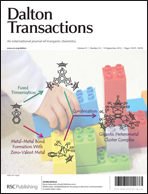Formation of M4Se4 cuboids (M = As, Sb, Bi) via secondary pnictogen–chalcogen interactions in the co-crystals MX3·Se![[double bond, length as m-dash]](https://www.rsc.org/images/entities/char_e001.gif) P(p-FC6H4)3 (M = As, X = Br; M = Sb, X = Cl; M = Bi, X = Cl, Br)†
P(p-FC6H4)3 (M = As, X = Br; M = Sb, X = Cl; M = Bi, X = Cl, Br)†
Abstract
The reactions of the group 15 trihalides, MX3 (M = As, Sb, Bi; X = Cl, Br), with the phosphine selenide SeP(p-FC6H4)3 result in the formation of co-crystals of formula MX3·SeP(p-FC6H4)3. No reaction was observed with MI3 (M = As, Sb, Bi). The structures of MX3·SeP(p-FC6H4)3 (M = As, X = Br 2; M = Sb, X = Cl 3; M = Bi, X = Cl 5; M = Bi, X = Br 6) have been established, and are isomorphous, crystallising in the cubic I23 space group. All the structures feature a primary MX3 unit, which has three weak secondary M⋯Se interactions to SeP(p-FC6H4)3 molecules. However, each of these SeP(p-FC6H4)3 molecules bridges three MX3 molecules, resulting in the generation of an M4Se4 (M = As, Sb, Bi) distorted cuboid linked by the
![Graphical abstract: Formation of M4Se4 cuboids (M = As, Sb, Bi) via secondary pnictogen–chalcogen interactions in the co-crystals MX3·Se [[double bond, length as m-dash]] P(p-FC6H4)3 (M = As, X = Br; M = Sb, X = Cl; M = Bi, X = Cl, Br)](/en/Image/Get?imageInfo.ImageType=GA&imageInfo.ImageIdentifier.ManuscriptID=C2DT31010D&imageInfo.ImageIdentifier.Year=2012)

 Please wait while we load your content...
Please wait while we load your content...
![[double bond, length as m-dash]](https://www.rsc.org/images/entities/h2_char_e001.gif) P(p-FC6H4)3 (M = As, X = Br; M = Sb, X = Cl; M = Bi, X = Cl, Br)
P(p-FC6H4)3 (M = As, X = Br; M = Sb, X = Cl; M = Bi, X = Cl, Br)